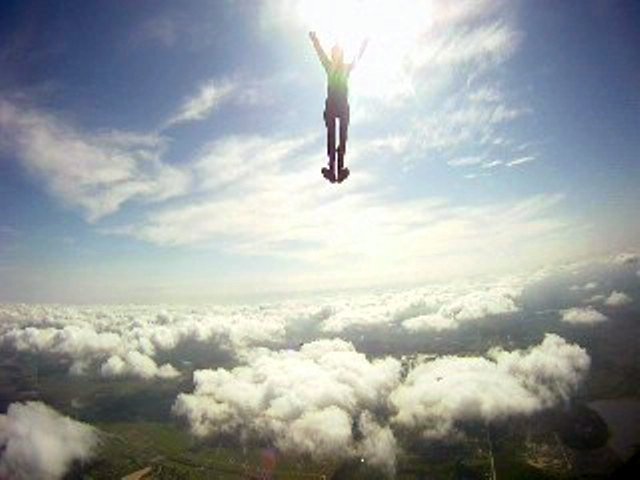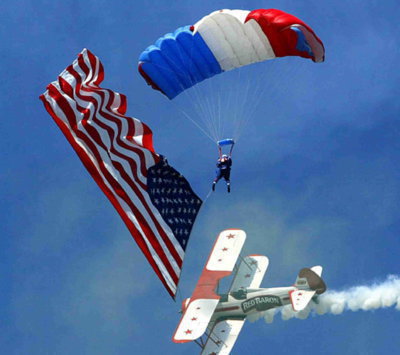
I have to second guess this serious advice, but again, I'm not sure... I would really like some input. Thank you.
By
boomslang, in Safety and Training
Recommended Posts
nigel99 687
QuoteI was questioning the time penalty's worth. That was kinda the whole question.
I think it is worth it (again note that I am not an instructor/experienced). Most of us will progress through the sport to having higher wingloadings and thus parachutes that are more likely to malfunction, secondly modern parachutes open more slowly (as a general rule).
I wonder how many people who have been low have actually dumped their reserve...
1. I saw the video and the talking of going for reserve when you are low came into question when I saw that he had, basically, saved his life by less than 1/8th of a second.
2. I stopped to think about it.
3. I started writing about what I thought in this thread.
4. The question of this thread was whether adding the training, which may become a possible liability in a bad scenario, would help, or if it should even be taught in the first place if instinct is to go for the main every time. And, is it even possible to override that instinct reaction.
Personally, I think the instinct reaction and quick critical thinking is what keeps people alive in this sport, and the people that cannot make the correct ones and be calmer under the pressure leave or don't make it.
If the ground had been flat and he had not followed the valley seam after opening, you are looking at about 1 - 1.5 second canopy ride.
That means if the canopy sniveled 1/4 second longer he'd inherit the earth.
Form the video, if he would have been a 100 meters over more, he would have impacted either prior to or during deployment, another 1/2 second before exiting and may have been right over the peak...cancel Christmas.
I think you are asking the wrong questions...!
When you put yourself that far into the reapers corner it's a crap-shoot no matter what handle you pull.
You need to be analyzing WHY & HOW he got into that situation in the first place.
If I were him... I would be very concerned about my altitude awareness and my spotting skills.
You put yourself in a position in which SEVERAL fraction of a second variables were the difference in your survival, living through that is the exception not the rule.
If that had happened to ME, I would for the rest of my Skydiving career work toward taking the steps to insure I never put myself in that situation again.
The main vs. reserve question is kind of a moot point, either handle was a 50/50 shot at best...that's a dead man walking, learn from it and don't go there.
~Regarding the question of muscle memory vs. thought, if you don't constantly train yourself to react properly and often differently to various possible scenarios your body will do what it's been doing.
I keep a picture in my head of a demo jump I was on years ago, exiting low because of weather...the guy ahead of me went one time for his main, the handle was buried in the pouch...in one smooth action he was under a deploying reserve. Nobody 'thinks' that fast, it was all reaction.
He had mentally prepared for just such a situation, when it happened he reacted as prepared...I was impressed and work to have skills like that.
~ If you choke a Smurf, what color does it turn? ~
sundevil777 102
No matter how much you ask for no thread drift, don't be surprised that it happens! ![]() . The force that drives thread drift should be harnessed as an energy resource.
. The force that drives thread drift should be harnessed as an energy resource.
I think that a small amount of time delay to decide to pull reserve may be compensated by the quicker opening. Even if that isn't exactly true, at least you won't have to deal with a 2 out, so that makes a slightly lower reserve activation altitude OK, as long as you aren't super low when you finally pull.
Did you have an audible for the wingsuit jump, and did it work? it isn't clear if you did from your response. I've found that I hear mine much better when wearing earplugs, I think that is a common experience. (see, there's more thread drift...)
QuoteOne time is different from "I have made mistakes with altitude awareness myself." Mistakes = plural, so I interpreted that as a recurring problem.
It felt very much like you were implying that this was an ongoing issue, which it is not. It has happened once where it was dangerous, other times I was being held on to an instructor, and stepping off a cessna in AFF. That is all.
QuoteI'm not saying it'll never happen - I'm human and I do make mistakes, which is why I shared my point about what I do with my audible and why I've made that choice. But since you seem to have some hostility about my sharing that (based on your response), perhaps I ought not to have bothered.
I think we both took each other's remarks down incorrectly and I apologize. I do not want to get into a personal debate here, I do not have the time right now and frankly, I do not want to waste my time or energy on that. I wanted a little input, and what you said immediately put me in the defensive.
And yes, please do not comment again. I want this thread closed.
QuoteOkay, here's an answer. I have thought about what I'd do at 1,600 feet without a parachute, and in various scenarios. The general rule is I would like to think I'm going to go for my reserve.
If I'm in an aircraft at 1,600 and the pilot says "Get out" in that time between "Get out" and getting to the door I should have enough time to look at my alti and decide which handle to pull (and at 1,600 feet it would be the silver one since that's right at the borderline and unless I'm 100% sure that plane's still flying straight and level, there's a good chance I'll be even lower by the time I leave).
If I'm at 1,600 feet under a malfunctioning main that I'm not confident I can land safely, I'm getting rid of it. Hopefully by that point I'm already executing my EPs since my hard deck is at 1,800.
If I'm at 1,600 feet in freefall, I would hope that I would go for my reserve, but there's a good chance that I, like most everyone else, would go for my main. My main opens fairly fast, but that's right at the "spook the AAD" altitude, so I might end up with two out. But since I'd rather end up with two out than none out, I figure I'm still better off going instinctively for my main than wasting time trying to decide.
Do you realize that this has nothing to do with what the thread is for... like, at all.
This thread isn't about sitting there and stopping time if you turn and look at the ground and it is coming at you like that. You can't stop and think about what you just wrote. It is about what to do when you have more adrenaline surge through you than you have ever had before. What is the best course of action? Is the action that is being advised the best? That is the only question I brought up. That is it. Stop writing. Read the post I wrote before this and it will save you a lot of time.
pchapman 281
Your original question was a good one, even if a bit wordy, one of those issues that has been in the back of my mind because I don't have a good answer for it.
I've seen someone write how by the time he thought, "I'm low, go for reserve!", his right hand had already dumped the main.
Maybe try the occasional jump where, altitude & traffic etc. permitting, you actually put a hand onto your reserve handle first? Maybe when not deploying too high, to give a slightly more realistic sight picture.
Or throw in a quick back loop or roll first to help give a slightly more sudden view, as if suddenly looking down to find oneself low.
This could be a good little emergency procedures practice for most people. Gotta try it myself too.
(If someone is a habitual high puller, they can take it lower occasionally to get used to the lower altitude, even if they don't want it to be an everyday thing. )
But then, as you question, how often does one need to do this to build it into one's instinctive procedures? Is once a season enough? Once per 50 jumps? Who knows.
It might not have to be very often at all, just that it is something one has actually done a few times to make it more than totally un-natural. When done occasionally, it may then also stick in the back of the mind as an option that comes to mind more easily when time is tight.
EDIT:
Nigel99 -- That 1000m vs. 1000ft incident is a great tale! Worthy of the 'stupid things I have done' or 'scary stories from the old days' threads.
Boomslang -- Give nwflyer a break. That last bit of hers that you quoted does relate to the thread. Like you and I, she also hopes she'd go to her reserve quickly when low, but we all have that nagging doubt we might toss the main before moving our left hand.
QuoteI watched that video a while back, he dodged a bullet...luck was on his side.
If the ground had been flat and he had not followed the valley seam after opening, you are looking at about 1 - 1.5 second canopy ride.
That means if the canopy sniveled 1/4 second longer he'd inherit the earth.
Form the video, if he would have been a 100 meters over more, he would have impacted either prior to or during deployment, another 1/2 second before exiting and may have been right over the peak...cancel Christmas.
I think you are asking the wrong questions...!
When you put yourself that far into the reapers corner it's a crap-shoot no matter what handle you pull.
You need to be analyzing WHY & HOW he got into that situation in the first place.
If I were him... I would be very concerned about my altitude awareness and my spotting skills.
You put yourself in a position in which SEVERAL fraction of a second variables were the difference in your survival, living through that is the exception not the rule.
If that had happened to ME, I would for the rest of my Skydiving career work toward taking the steps to insure I never put myself in that situation again.
The main vs. reserve question is kind of a moot point, either handle was a 50/50 shot at best...that's a dead man walking, learn from it and don't go there.
~Regarding the question of muscle memory vs. thought, if you don't constantly train yourself to react properly and often differently to various possible scenarios your body will do what it's been doing.
I keep a picture in my head of a demo jump I was on years ago, exiting low because of weather...the guy ahead of me went one time for his main, the handle was buried in the pouch...in one smooth action he was under a deploying reserve. Nobody 'thinks' that fast, it was all reaction.
He had mentally prepared for just such a situation, when it happened he reacted as prepared...I was impressed and work to have skills like that.
I agree in absolute. I asked a very specific question and I am regretting bringing it up in this forum because I know these threads always, without any doubt, unless they are in a very specific forum, de-rail. This is not about 15k to 3k. This is about after that. The moment nothing can be taken back and no matter how many times you (not you) have said "I will never be in that position," it is about that time it happens to someone and they don't have time to even say ****, how did I end up at this altitude, ok.. so what do I do. I asked a simple debate about whether training to go for silver at that altitude is worth the risk basically. Can we close this thread now please.
QuoteDon't worry about the implied criticism too much. It's just the way it is here, that all sorts of related issues are brought up and questioned, and alternative ideas explored, rather than dealing with one very specific question one is asking about.
Your original question was a good one, even if a bit wordy, one of those issues that has been in the back of my mind because I don't have a good answer for it.
I've seen someone write how by the time he thought, "I'm low, go for reserve!", his right hand had already dumped the main.
Maybe try the occasional jump where, altitude & traffic etc. permitting, you actually put a hand onto your reserve handle first? Maybe when not deploying too high, to give a slightly more realistic sight picture.
Or throw in a quick back loop or roll first to help give a slightly more sudden view, as if suddenly looking down to find oneself low.
This could be a good little emergency procedures practice for most people. Gotta try it myself too.
(If someone is a habitual high puller, they can take it lower occasionally to get used to the lower altitude, even if they don't want it to be an everyday thing. )
But then, as you question, how often does one need to do this to build it into one's instinctive procedures? Is once a season enough? Once per 50 jumps? Who knows.
It might not have to be very often at all, just that it is something one has actually done a few times to make it more than totally un-natural. When done occasionally, it may then also stick in the back of the mind as an option that comes to mind more easily when time is tight.
That was a very insightful post. Thank you.
I have made 6+ actual pre-deployment procedures as you described, and that is why, when I read that reply to the video I has to ask... It has been on my mind.
I think that it would take more practice than is practical to really override that natural response of pitching the main.
Quote
To address that~
How many people actually practice pulling handles?
I do to an extent, 100 times a week before I jump...sounds excessive but it's a habit I got into when I started, muscle memory was something I got into through Karate training.
I put my hands out as if in free-fall then go through various scenarios in my head...some require a cutaway some don't. The point is I have my hands on the handles 100 times before jumping...it takes less that 10 minutes.
I also somewhat imprinted in my mind that I worship the big silver handle on my left, as my aw shit salvation.
When things go south that's my FIRST reaction, go for silver...I got hit pretty hard in free-fall once, it hurt like Hell & flipped me over on my back, as I took the 1/2 second to sort out what happened I noticed my thumb was already in the D-ring.
You DO what you train for.
~ If you choke a Smurf, what color does it turn? ~
QuoteNo matter how much you ask for no thread drift, don't be surprised that it happens!
. The force that drives thread drift should be harnessed as an energy resource.
I agree. I know one forum in particular.
QuoteI think that a small amount of time delay to decide to pull reserve may be compensated by the quicker opening. Even if that isn't exactly true, at least you won't have to deal with a 2 out, so that makes a slightly lower reserve activation altitude OK, as long as you aren't super low when you finally pull.
I also agree that the reserve is the best one to hit but it was more an impossible question of a very complicated response to a situation, and as we can see from the video, his response to the situation was his instinct, which was his main, and he was pretty lucky to say the least.
QuoteDid you have an audible for the wingsuit jump, and did it work? it isn't clear if you did from your response. I've found that I hear mine much better when wearing earplugs, I think that is a common experience. (see, there's more thread drift...)
I always wore an audible for my wingsuit jumps. I really enjoy wingsuits. I picked it up very quickly and I did notice that the audible was much louder, well, I was falling at less than half the speed that I normally do so it should be louder.
I agree in absolute. I asked a very specific question and I am regretting bringing it up in this forum because I know these threads always, without any doubt, unless they are in a very specific forum, de-rail. This is not about 15k to 3k. This is about after that. The moment nothing can be taken back and no matter how many times you (not you) have said "I will never be in that position," it is about that time it happens to someone and they don't have time to even say ****, how did I end up at this altitude, ok.. so what do I do. I asked a simple debate about whether training to go for silver at that altitude is worth the risk basically. Can we close this thread now please.
Quote
No...I think you're getting us all back on track regarding the meat of your question.
Let's run with it awhile, it's an important topic!
~ If you choke a Smurf, what color does it turn? ~






Hey now, chill out on the defensiveness. I responded to exactly what you wrote. One time is different from "I have made mistakes with altitude awareness myself." Mistakes = plural, so I interpreted that as a recurring problem.
So far, no, I've not ever completely lost altitude awareness. Have I opened lower than I would like/planned? Yes, but always with the awareness that I was lower than I planned to be (traffic at some point during the breakoff/tracking process is generally the cause of that).
I'm not saying it'll never happen - I'm human and I do make mistakes, which is why I shared my point about what I do with my audible and why I've made that choice. But since you seem to have some hostility about my sharing that (based on your response), perhaps I ought not to have bothered.
Okay, here's an answer. I have thought about what I'd do at 1,600 feet without a parachute, and in various scenarios. The general rule is I would like to think I'm going to go for my reserve.
If I'm in an aircraft at 1,600 and the pilot says "Get out" in that time between "Get out" and getting to the door I should have enough time to look at my alti and decide which handle to pull (and at 1,600 feet it would be the silver one since that's right at the borderline and unless I'm 100% sure that plane's still flying straight and level, there's a good chance I'll be even lower by the time I leave).
If I'm at 1,600 feet under a malfunctioning main that I'm not confident I can land safely, I'm getting rid of it. Hopefully by that point I'm already executing my EPs since my hard deck is at 1,800.
If I'm at 1,600 feet in freefall, I would hope that I would go for my reserve, but there's a good chance that I, like most everyone else, would go for my main. My main opens fairly fast, but that's right at the "spook the AAD" altitude, so I might end up with two out. But since I'd rather end up with two out than none out, I figure I'm still better off going instinctively for my main than wasting time trying to decide.
Share this post
Link to post
Share on other sites